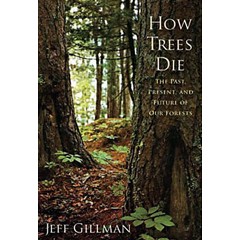
"A tree," states Jeff Gillman in his new book, How Trees Die: The Past, Present, and Future of Our Forests, "can be briefly defined as a tall plant with a woody stem which survives for more than a single year." But a tree is so much more than that. In this slim and personable exploration of -- well, how trees die -- Gillman, a University of Minnesota horticultural professor who specializes in tree research, offers an insightful and surprisingly witty and compassionate look at the lives and deaths of trees. Whether you're considering planting a fruit tree in your backyard or pondering the future of our forests, this book offers a unique and informed perspective.
Gillman, who also wrote The Truth About Organic Gardening: Benefits, Drawbacks, and the Bottom Line and The Truth About Garden Remedies: What Works, What Doesn't and Why, both from Timber Press, examines the ways in which trees live and die from several perspectives, all of them personal and most of them informed by how humans interact with trees.
He begins with the story of his favorite tree, one that his grandfather planted and he and his brother loved to climb. Its tightly clustered low branches made it a great climbing tree. The trunk was split into three or four pieces, giving Jeff and his brother plenty of ways in and out of the tree. But this also meant that the branches were prone to breaking in a storm. Ultimately, the tree grew so weak that it had to come down. It was his first experience with the life cycle of a tree.
Since then, Gillman's research has led him to subject trees to every kind of stress. "I consider it my job," he writes, "to plant trees in ways that most landowners would never so that I can report what happens and prevent others from making the same mistakes." He overfeeds them, underwaters them, plants them at the wrong depth, sprays herbicides on them, and otherwise tortures them in the name of learning how to help them survive.
But before he gets to that, he takes us through a history of trees in their natural and not-so-natural environments. In his chapter on forests he explores forestry and his own take on forest management, tracing the life of one individual pine tree from seedling to sawmill. He examines the impact of exotic imported trees like the Norway maple. He follows the life cycle of an apple tree in the orchard, explaining what a strain it is for a large, mature fruit tree to continue to draw enough water from the ground to reach all its leaves and branches. "Trees grow themselves into a tough situation," he says. Scientists still don't know exactly what happens when an old tree dies of natural causes, but the difficulty of moving enough food and water to every extremity is certainly a major factor in why elderly trees get weak and have trouble rejuvenating themselves.
What else imperils a tree? Disease and pest infestations. The plague of Dutch elm disease. Asian longhorned beetles and emerald ash borers. Stowaways and imports, all brought here by humans. The ways in which we test the limits of what a tree can tolerate even include what Gillman calls "zone pushing" -- collectors who bring exotic trees into climates they can only barely tolerate for the sake of brightening up the garden. Eventually these exotic trees can succumb to opportunistic fungal infections that prey on trees under stress.
But the most fascinating chapter in the book -- and the one I think gardeners should consider carefully before the winter bareroot tree-planting season arrives -- is called "Loved to Death." Gillman compares an over-loved tree to a 25-pound cat -- all that love and attention can bring on a heart attack. A tree that gets too much water, a tree with mulch piled around its base in the shape of a volcano, a tree covered with black spots to mark the places where it has been pruned excessively -- these are all trees that die from too much of our loving care.
Gillman has been researching tree-planting and tree care techniques at his experimental plot at the University of Minnesota for a decade now; he has learned, for instance, that planting a tree too deeply will cause the roots to grow upward in search of the right balance of water and air. In the process the roots tend to get disoriented and grow inward toward the tree's trunk, strangling it. Instead he advises planting it so the root crown is just visible, the way it might grow in a forest. If it looks like a lollipop -- a stick coming out of the ground -- it's planted too deeply.
He explains why adding fertilizer and soil amendments to a hole before planting a tree can actually harm it. Too much phosphorus, for instance, can actually inhibit rather than stimulate root growth. Too much light, rich compost essentially creates a bowl underground that will fill with water. He describes the harm inflicted by pruning a branch flush with the trunk of the tree (it unnecessarily damages tissue along the trunk); using sealant to "seal tree wounds" (trees don't bleed and there is no evidence that it helps prevent infection); and piling mulch around the base of the tree (it harbors bacteria and fungi while encouraging the roots to grow up rather than down.) The best way to care for a tree, it seems, is to stand back and give it as little care as possible.
It's a fascinating book, full of personal insights and the results of Gillman's own research. The way he traces the lives of individual trees to help illustrate how trees move into old age and death helps remind us that, in fact, every tree is an individual.
You can find out more about Jeff Gillman at jeffgillman.net, and How Trees Die is available wherever books are sold.
Comments